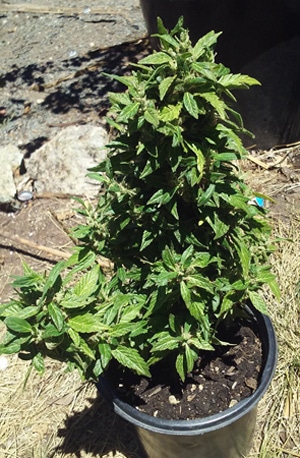We all know the standard image of the cannabis leaf, right? By this point, you’ve probably seen it about a million times imprinted on lighters, shirts, websites, and just about everything else!

Typical Cannabis Leaf Shape
Now before you examine the picture too closely, answer this: How many “fingers” or “points” is a cannabis leaf supposed to have? (more formally called “leaflets”, “segments” or ‘lobes”)
Don’t feel bad if you don’t know. It’s a trick question.
Cannabis leaves usually change the number of fingers/points on their leaves as they mature. The number we’re most familiar with seeing is the leaf with 7 points, but cannabis leaves can naturally grow leaves with 1-13+ points!
Cannabis leaves on young plants almost always start with fewer points. The following progression shows what leaves typically look like from seedling to adult.
Normal Leaf Progression
Two round cotyledon leaves emerge from inside the shell during germination. After that, the seedling grows two serrated leaves (“real” leaves) with one point.
The first set of serrated leaves have just one point.
When the plant grows the next set of leaves, they usually have 3 points.
The next set of leaves typically have 5 points once they’ve grown in. I put a red dot at each point to help you see them better.
By the 4th set of serrated leaves and beyond, leaves typically have 7 points each. Most plants will continue making 7-point fan leaves for the rest of their life.
However, most adult plants will occasionally make 9-point leaves, especially when growing fast with lots of light.
This outdoor plant has a 9-point leaf in the middle of the picture (where it’s getting a lot of sun), though most leaves on the plant are 7-point.
It’s entirely ordinary for cannabis leaves to have 9, 11, or even 13+ points. It’s rarely the sign of a problem. They often appear on healthy, fast-growing plants.
What about other numbers of “points”?
Sometimes you’ll see other numbers of points. This can be the result of several factors. Some causes are benign (it’s just genetics for some plants), but sometimes weird-point leaves are a symptom of something bad happening. You no longer need to wonder. Without further ado, here’s info about other possible numbers of points you might see!
1-Point Leaves
It’s normal to see single-point “sugar leaves” after your plant has started making buds. These are much smaller than regular leaves, and the base of a sugar leaf is inside the bud.
1-Point “Sugar Leaves” emerging from buds are normal.
Autoflowering Lemon OG HazeSugar leaves appear “tucked in” the buds during the flowering stage.
Sometimes you’ll see 1-point leaves as the results of genetics or a mutation. You know this is the case when your otherwise healthy plant grows 1-point leaves from seed to harvest.
Examples of 1-point leaves from genetics or a mutation
Plant grows with single-finger leaves .This is normal genetic variation. Nothing is wrong here.
Here’s another cannabis plant that only grew single-point leaves from seed to harvest.

Sometimes 1-point leaves are the sign of a problem!
You should be concerned if your plant starts growing 1-point fan leaves as an older plant, especially if the leaves are rounded and appear on long stems. That’s often a sign the plant is “re-vegging”.
A re-vegged plant will grow round single, triple, or quintuple pointed leaves at first, before it starts growing regular serrated leaves.
Re-vegetating a plant means you take a flowering/budding plant and put it back in the vegetative stage. It is also sometimes referred to as “Monstercropping” or “Monster Cropping.” This refers to the fact that a revegged plant will tend to grow much bushy than a plant grown from seed.
Some growers like to reveg a plant on purpose after harvest, instead of throwing it away.
Benefits to re-vegging (monster cropping)
you don’t have to plant a new seed or clone
possibly saved vegetative time
no need to dispose of harvested plant
re-vegged plants grow back bushier (sometimes to an extreme)
Downsides to re-vegging (monster cropping)
it takes a long time for a flowering plant to re-veg
initial growth is strange and stretchy, with round leaves
plant training may be more difficult as plant already has set structure
yields are often lower than the first time around
3-Point Leaves
It’s normal to see 3-point leaves on a young seedling, and occasionally you’ll have a plant that keeps growing 3-point leaves as an adult due to normal genetic variation. But sometimes it’s a sign of a problem.
What causes 3-point leaves?
Genetics – Some strains grow 3-point leaves no matter what you do — for example, any Ducksfoot strain. If plants are otherwise healthy and grow 3-point leaves from seed to harvest, you likely don’t need to worry.
Environmental stress – Extreme temperatures, underwatering, stagnant air, and other stresses can trigger the plant to start growing 3-point leaves
Light stress – Especially a significant change in light type or light levels
Unusual photoperiods – For example, if grow lights turn on and off at a new time, or you otherwise change your lighting schedule. Some growers have seen them after switching plants to 12/12 to initiate the flowering stage.
Re-vegetating – If a plant starts flowering (making buds) and then switches back to the vegetative stage, it can cause leaves to grow with 3 points. Learn more about re-vegging.
Some strains such as the Ducksfoot strain naturally grows 3-point leaves no matter what.
However, if a plant “reverts” back to 3-point leaves, you should be concerned.
These plants were growing typical leaves, but after being switched from a fluorescent light to a powerful LED, all the leaves started growing in with 3-points as a stress response. However, they quickly adjusted to the light and began to grow regular leaves again within a few weeks.
These outdoor plants in Australia began to grow 3-point leaves after massive bush fires created smoke that blocked out the sun. The odd light periods caused the 3-point stress response.
If you know why your plants started growing 3-point leaves, all you need to do is correct the issue (or potentially wait for them to grow out of it). But if you see 3-point leaves appear out of nowhere, don’t ignore it! Try to determine what’s causing the change.

Plants do this all the time. Any strain can exhibit 3 fingered leaves. Lots of them kick out 1 bladed leaves once in a while if stressed or revegged. Also most seedlings kick out 3 blades before then kicking out 5 on the next chute. If it’s a seedling then that’s the reason. The next will have more blades.